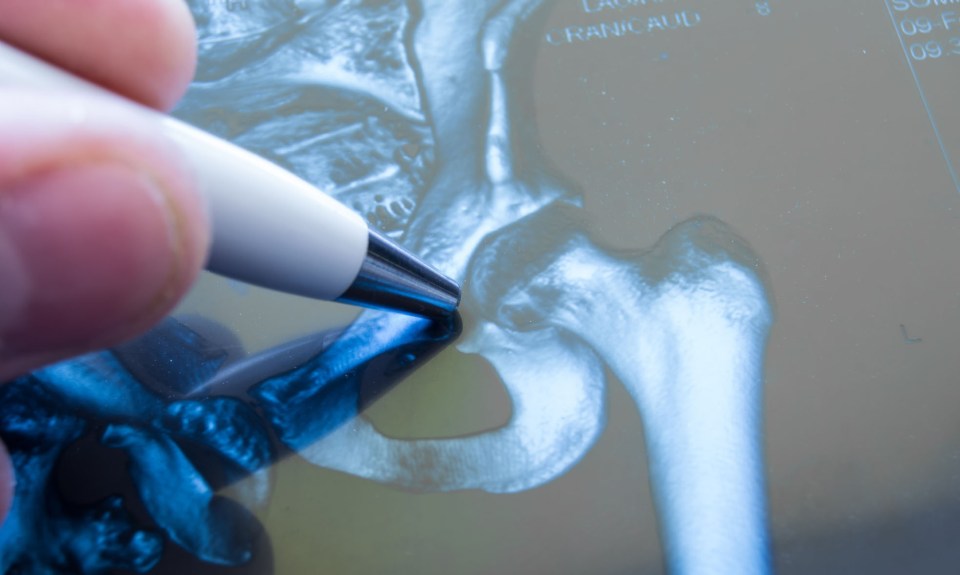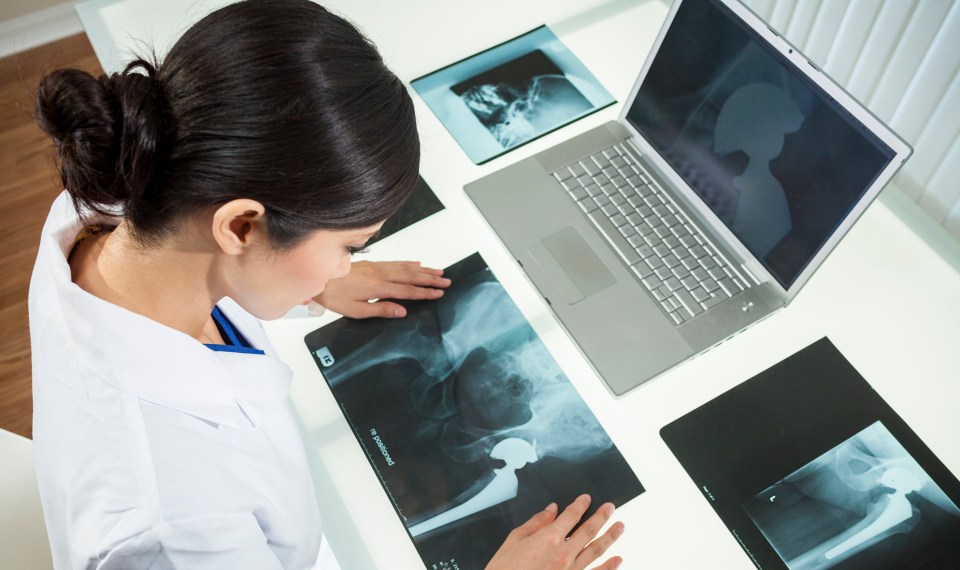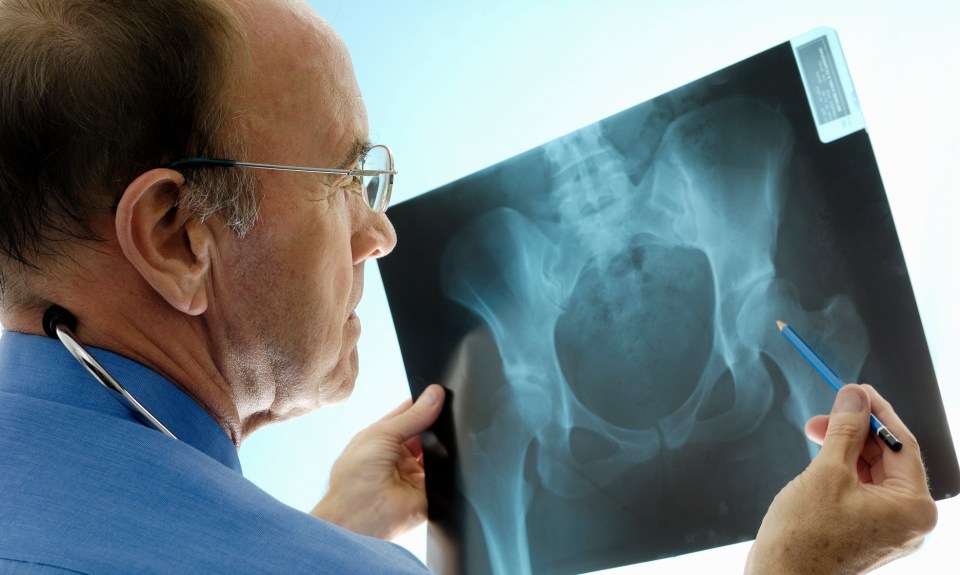A hip fracture (broken hip) is a serious injury that typically occurs in those age 65 or older and is more common in women due to bone weakening caused by osteoporosis. Most broken hips—over 95 percent—are caused by falls and can threaten mobility and independence. Prompt hip repair followed by a well-coordinated rehabilitation program offers the best chance for a complete recovery, but every injury is different, and hip fracture recovery timelines can vary.
A broken hip will likely require surgery. If so, rehabilitation should start almost immediately following.
“They are going to want to get you up and moving as soon as possible, usually within 24 hours,” said Megan Lopez, a senior physical therapist at Encompass Health Rehabilitation Hospital of Fayetteville. “That prevents muscle atrophy or bed rest implications.”
Types of Hip Fracture Surgeries and Recovery
There are four main types of hip fracture surgeries:
- Total hip replacement. During this surgery, the hip joint is removed and replaced with artificial parts. This is the most invasive of the four, Lopez said.
- Hemi-arthroplasty. Only part of the hip joint is removed and replaced with artificial parts in this surgery.
- Percutaneous pinning. This is the least invasive. A pin is inserted through a small incision near the hip to stabilize the bone.
- Open reduction internal fixation. This surgery places the fractured bone back into the correct position.
After surgery, a typical hospital stay in the acute care hospital is from two to four days, or up to a week, although your stay may be longer or shorter. If you were healthy and active before the injury, you may even be a candidate for outpatient hip surgery, returning home the same day. It is important to begin moving as soon as possible after surgery to help you regain full mobility and lessen the risk of complications, such as blood clots. Over-the-counter and prescription pain medications will be given to help manage the pain, and antibiotics may be prescribed following surgery.
When Should Therapy Begin?
Therapy starts almost immediately after the repair procedure. You may transfer to a chair within hours after surgery and may even stand. On the first or second day you may be encouraged to place full weight on your injured side, depending on your type of fracture and repair. You may require a cane, walker or crutches while you heal.
Often patients are fully weight-bearing almost immediately after surgery, but depending on the type of fracture and repair, you could be designated non-weight bearing or partial weight-bearing. Your physical therapist and healthcare team will instruct you on when and how to start bearing weight.
A physical therapist may work on standing and bed transfers with you to get you moving again.
Your care team will also instruct you on hip precautions you may need to take based on the severity of your injury and the invasiveness of the surgery. These precautions could be in place for six to 12 weeks post surgery.
“That could include not bending your hips past 90 degrees, not crossing your legs or rotating your toes inward,” Lopez said. “For those who have either hemi- or total hip replacement, we would recommend you go to inpatient rehabilitation because education is needed on hip precautions and any weight-bearing precautions.”
Inpatient Rehabilitation for Hip Fracture Recovery
At an inpatient rehabilitation facility, a team of physicians, therapists and nurses will assist you with recovery. Keep in mind healing is often slower in elderly people. Successful rehabilitation requires a customized care plan designed to fit your diagnosis, abilities and goals.
A typical inpatient rehabilitation stay is between 7–14 days, although some patients may require more time. In this setting, your therapy will be more complex and will focus on making sure you are able to safely return to your community and can perform everyday activities.
During your stay, you will receive three hours of therapy, five days a week. Your physical and occupational therapists will work to help you build up your strength and ensure you can perform basic self-care tasks.
“That’s one of the main benefits of coming to an inpatient rehabilitation hospital,” Lopez said. “We have an interdisciplinary approach. PT and OT will be working hand in hand. There are also educational sessions, so we’ll be providing you with education on hip fractures, diet, fall prevention, supplements and more. Nursing can also help educate on medications and wound care from your surgery, so you have that side, as well.”
In addition to therapy and nursing, you will also have a case manager who can help connect you to resources in your community after you leave the hospital, such as transportation.
Your physical condition and activity level before your hip fracture play an important role in your post-surgery recovery. A positive outlook and a willingness to work hard on recovery have also been shown to be very beneficial for elderly people recovering from hip fracture.
Early rehabilitation and movement help prevent blood clots and muscle atrophy. Your therapists will assist you in exercises designed to help you regain strength and balance with a goal of performing activities of daily living, walking and stair climbing as tolerated. Expect to start slowly and build as your strength and endurance increases.
Outpatient Rehabilitation for Hip Fracture
Since it can take several weeks or months to recover from a broken hip, outpatient therapy may be required. If you were discharged to inpatient rehabilitation after surgery, you’ll continue to expand on the progress you made during that stay, working with physical and occupational therapists to improve your range of motion, strength and daily activities. If your hip fracture and surgery were relatively non-invasive, you could return home immediately after hospitalization, and will likely need outpatient therapy.
Outpatient therapy could last from four to eight weeks. During this time your pain should lessen, while balance and mobility continues to improve. If you were active before your injury and do not have other health issues, recovery may be faster. Many hip fracture patients can drive again approximately six weeks after surgery and return to activities like golf and cycling within 12 weeks. If you had a total hip replacement, recovery time may be six months or longer.
Keep in mind, achieving full recovery requires a certain degree of self-discipline. Just because therapy sessions have ended, daily exercise, a healthy diet, regular social interaction and a positive attitude are still needed for continued improvement. The time and effort you put into your recovery will point you toward an active, healthy lifestyle going forward.
The content of this site is for informational purposes only and should not be taken as professional medical advice. Always seek the advice of your physician or other qualified healthcare provider with any questions you may have regarding any medical conditions or treatments.



